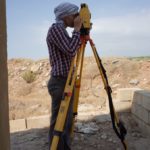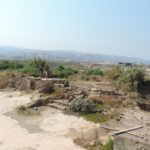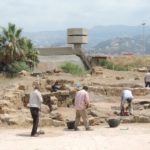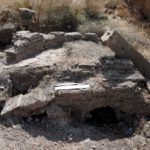Khalde
Qobbet Ech Choueifat
-
Project name:
Polish-Lebanese Archaeological Mission to Khalde (Qobbet Ech Choueifat)
Facebook:
-
Type of site:
Settlement
Location:
Lebanon
Southern suburbs of Beirut
Central PhoeniciaDating:
– Chalcolithic (5500–3700 BC)
– Late Bronze Age (1400–1150 BC)
– Iron Age (1150–530 BC)
– Persian period (530–330 BC)
– Hellenistic period (330–63 BC)
– Roman period (63 BC–324 AD)
– Early Byzantine period (324–641 AD)
Most interesting finds:
– Phoenician cemetery from the Iron Age with more than 400 identified graves
– Wineries from the Roman/early Byzantine period
– Storerooms
– Baths
– Early Byzantine mosaics
History of research:
Dates of PCMA mission’s work:
2007, 2017
Type of research:
Survey
Directors:
Tomasz Waliszewski, Institute of Archaeology, University of Warsaw (2007)
Mariusz Gwiazda, Polish Centre of Mediterranean Archaeology, University of Warsaw (2017)
Co-operating institutions:
– Polish Centre of Mediterranean Archaeology, University of Warsaw
– Direction Générale des Antiquités du Liban
Additional information:
The first archaeological research in the area started in 1960 and was directed by H. Kalayan. Baths and houses with mosaics with geometrical motifs, dated to the Roman and early Byzantine period, were found. In the following years, under the direction of R. Saidah, an Iron Age cemetery with more than 400 graves was discovered. In 2007, the Polish-Lebanese mission directed by T. Waliszewski documented parts of an oil press located at the border between the site and a highway.
Description of the site and research:
The archaeological site of Khalde lies more than 2 km to the south of the Beirut district Awza’i and 180 m from the coast of the Mediterranean Sea. On the east, it borders with the R. Hariri Airport in Beirut and the highway leading to Sidon. The extent of ancient remains is limited from the north and south by modern buildings. The area covers 0.8 ha and is called Qobbet Ech Chouaifat. The remains of ancient structures are located on the top and at the base of a rocky outcrop of sand conglomerate.
The Polish-Lebanese mission found mostly the remains of a Roman and early Byzantine settlement. Numerous wineries with large vats for storing grape juice were identified. Such buildings are rare in Lebanon, although the Phoenician production and export of wine are well documented in historical and archaeological sources. The large number of wine pools found in Khalde confirms the large scale of local production. Amphorae used for transporting this wine were most probably also produced in the settlement. While the wine was maturing, these containers were presumably stored in a partly-uncovered storeroom. Its lower part was cut directly in the bedrock, guaranteeing low temperatures inside the building. The mission also documented parts of an oil press which shows the diversity of the local agricultural production.
Khalde is one of a few Phoenician villages where the remains of baths from the Roman and early Byzantine period have been found. It means that the people living in this settlement had access to luxurious installations. The relative wealth of Khalde’s inhabitants is also evidenced by the discovered mosaic floors with geometrical and floral motifs.
Gwiazda, M., Wicenciak, U., Rzeźnik, S. & Waliszewski, T. (w druku). Archaeological works in Khalde (Qobbet Ech Choueifat) during 2017, Bulletin d’Archéologie et d’Architecture Libanaise
Waliszewski, T. (2014). Elaion. Olive Oil Production in Roman and Byzantine Syria–Palestine, (=PAM Monograph Series 6), Warszawa: PCMA, Wydawnictwa Uniwersytetu Warszawskiego
Wybrana bibliografia stanowiska:
Saidah, R. (1967). Fouilles de Khaldeh. In Bulletin du Musée de Beyrouth 20, 165–169.
Saidah, R. (1966). Fouilles de Khaldeh. In Bulletin du Musée de Beyrouth 19, 51–90 pls. I–VI.
Saidah, R. (1965). Fouilles de Khaldeh. In Bulletin du Musée de Beyrouth 18, 116–117.
Gallery:
-
1. One of the members of the mission taking geodesic measurements / Jedna z członkiń misji w trakcie dokonywania pomiarów geodezyjnych (fot. M. Gwiazda)
-
2. Remains of stone quarries and wineries with vats for storing grape juice / Pozostałości kamieniołomów i winiarni ze zbiornikami na sok z winogron (fot. M. Gwiazda)
-
3. Workers during the cleaning of one of the wineries / Robotnicy w trakcie odczyszczania jednej z winiarni (fot. M. Gwiazda)
-
4. Cleaning of the wine storeroom and baths / Prace odczyszczające na terenie magazynów na wino i term (fot. M. Gwiazda)
-
5. Ortophotography of a winery after its partial uncovering in the 2017 season / Ortofotografia winiarni po częściowym odsłonięciu w sezonie 2017 (S. Rzeźnik)
-
6. Winery with a vat for storing grape juice after partial cleaning / Winiarnia ze zbiornikiem na sok z winogron po częściowym odczyszczeniu (fot. S. Rzeźnik)
-
7. Remains of a hot water pool in the baths / Pozostałości basenu z ciepłą wodą w termach (fot. M. Gwiazda)
-
8. Early Byzantine mosaic with the depiction of a vessel with leafy vines / Wczesnobizantyjska mozaika z przedstawieniem naczynia z wychodzącymi z niego wiciami (fot. M. Gwiazda)
-
9. Mosaic with geometrical motifs and a Syriac inscription / Mozaika z motywami geometrycznymi i inskrypcją syriacką (fot. M. Gwiazda)











